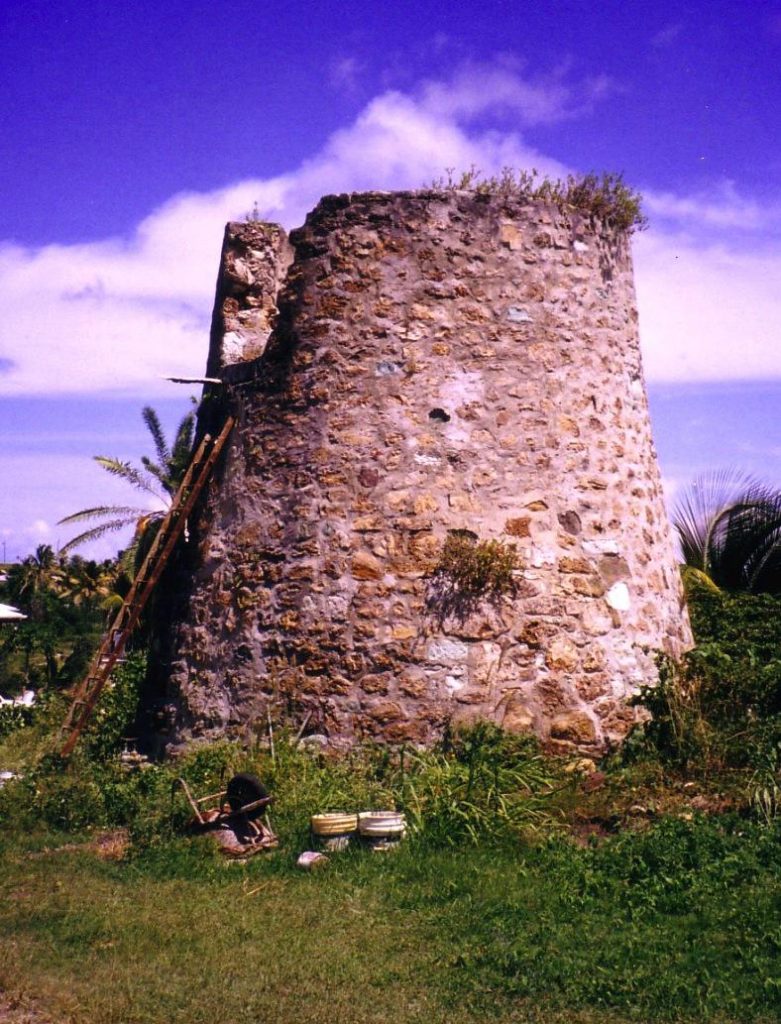About
Type: Extant
Parish: St.John
Founding date: 1672
See on Google Maps!

Current Status
In 1665/66, Colonel Buckley played an active role in Britain’s conflict with Holland, Denmark, and France. The signing of the capitulation agreement with the French by Lt. Col. Bastien Baijer, Col. Buckley, Joseph Lee, Capt. Samuel Winship, capt. Philip Warner and James Halliday, all arms, ammunition, forts, batteries, etc., were to be given up to the French. The English, however, were allowed to retain their property, and have free exercise of their religion, and Col. Carden, a prisoner of war, was restored to liberty.
The village of Buckley’s was founded after 1843 and the abolition of slavery a decade earlier. The Buckley’s area is noted for being especially fertile, receiving more than the average rainfall in the rest of Antigua. The sugar mill stands as testimony to the days when sugar was king, and the giant rollers used to crush the cane were powered by wind in the mill’s blades. There is no record that the mill was converted to steam.
Estate Related History/Timeline
In “1665/66 Colonel Buckley played an active part in the conflicts with Holland, Denmark, and France. During the signing of the capitulation with the French, Lt. Colonel Bastien Baijer, Colonel Buckley, Joseph Halliday, Capt. Samuel Winthrop, Capt. Phillip Warner and James Halliday, all arms, ammunition, forts, buttresses, &c., were to be given up to the French, but the English were to be allowed to retain their property, have free exercise of their religion, and Colonel Carden, a prisoner of war, was to be restored to liberty.” “Antigua and the Antiguans”
Elias Buckley, an Antiguan planter, was named in the 1672 will of John Bridges, also of Antigua.
There were two men named Daniel Hill, the Elder and the Younger. The elder is purported to have died in 1808, and there is a record that William Lee and George Wickham Washington Ledeatt were their executors, but no will has been located for Daniel Hill the Elder.
“The Cranstouns are the one family for which there is a direct heritage line from the free coloured family into the 20th century. The living Cranstouns descendants had no idea of their heritage until advised by a relative from Canada that their great-grandfather had been a prominent free coloured gentleman. “As with the Shervington’s the earliest family identification begins with the petition signers. There is no Cranstoun genealogy in Vere Oliver’s historical volumes. By the 1830s, the free coloured family was prominent: two brothers, David and George, signed the free coloured petition, while a sister, Ann, was President of the Female Orphan’s Aslyum. She never married, but a second sister, Jane, married into another prominent free coloured family named Weston.” Dr. Susan Lowes
In 2011 David Cranstoun began extensively researching his family’s genealogy, and noted that David Cranstoun — his great, great grandfather — a man of colour, purchased Buckley’s from Daniel Hill (1790) and was compensated for 23 slaves by the British government, most likely a Legacy payment from Parliament for granting freedom to the slaves.
The estate was not cultivated after 1820, and was leased in 1836 to U.S. Ambassador Ralph Higgenbottom, a manager of the Athill estate, and Buckley’s was later sold when, like his neighbors in nearby Swetes, David Cranstoun sold some of his estate to the laborers, encouraging Buckley’s as a free village. David managed Seaforths (#160) for Justin Casamajor, plus Robert Sutton’s mother on the Willis Freeman estate (#143), and several other plantations during his lifetime. He was attorney for William Manning, and in 1830, when Manning and Anderdon of the New York Bank Building in the City of London purchased Carlisle’s estate (#60), he was appointed their “true and lawful attorney.” Cranstoun was known as “Mr. Justice.”
Joseph Gravenor Buckley married Elizabeth Doig, a spinster, in 1801.
Enslaved People’s History
Based on contemporary research, we have little information to share about the enslaved peoples from this plantation at this time. A fact of interest is that in 2011 David Cranstoun began extensively researching his family’s genealogy and noted that David Cranstoun — his great, great grandfather — a man of colour, purchased Buckley’s from Daniel Hill (1790) and was compensated for 23 slaves by the British government, most likely a Legacy payment from Parliament for granting freedom to the slaves. We will continue our quest for more information about these vital individuals.
Ownership Chronology
- 1672: Elias Buckley. Named in the 1672 will of John Bridges of Antigua
- 1750: Colonel Daniel Mathew
- 1759: Richard Buckley. His 1759 will stated the estate was to be sold
- 1790: Daniel Hill d. 1808. (1777/78 map by cartographer John Luffman.)
- 1828: David Cranstoun (1795-1865)
- 1843: Plots sold to establish the free village of Buckleys
- 1872: W. B. Nibbs. 98 acres. Several smaller holdings of 10 acres each were owned and farmed by Samuel Edwards and the heirs of Isaac Kilsick
- 1878: Reverend Thomas Nibbs
- 1933: Reverend W. M. Williams (1933 Camacho map.)